Make the most of your time stuck at home by observing the birds in your backyard. If you live in a city, maybe you have birds nesting on your building. If you live in a house, you might have birds nesting in the bushes out front or under the eaves of your garage.
Wherever you are, you can enjoy the wonders of breeding birds from home.
Atlasing around the home is a great way to engage other members of your household in your favorite pastime. Maybe you start a journal to document behavioral observations. Or maybe you start a photo journal, capturing breeding birds on camera. Or your kids may find they want to try their hand at drawing the birds at your feeders. However you decide to enjoy the birds that make their homes around us, please remember to enter your observations in the atlas. Birds in residential areas are just as important to document as birds in more wild places.
Here are some of the birds you are likely to encounter around the home.
Quick links
- Mourning Dove
- Eastern Phoebe
- Blue Jay
- Barn Swallow
- House Wren
- European Starling
- Gray Catbird
- American Robin
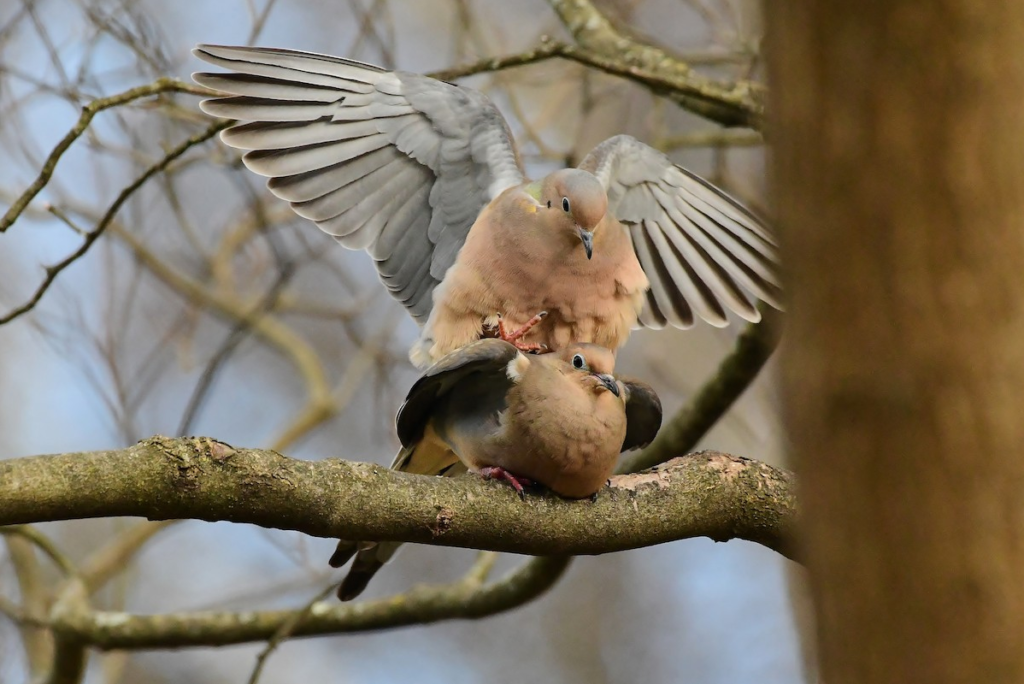
Mourning Doves copulating by Robert Howard/Macaulay Library
Mourning Dove
- Distribution: found in 90% of blocks in the second atlas
- Breeding Season: mid-March through August
- Habitat: varied—open and cultivated areas with trees and shrubs
- Nest Site: tree or shrub, sometimes builds on top of old nests of others species
- Nest: loose stick platform lined with finer twigs
- Eggs: 2 white, slightly glossy eggs
- Incubation: 14-15 days, both sexes
- Fledging: leave nest at 20-22 days, fed by both parents
- Independence: fed by both parents another 4-5 days
- Broods: 2-3
- Interesting Fact: males usually incubate during the day and females have night duty
- Common Atlas Codes: CN, NB, ON, FL, NE, NY
- Atlas Tip: With careful observation you can learn to distinguish some male and female doves. Males are slightly larger, have a pinkish breast, a blueish crown, and a pink iridescent patch on the side of the neck. Males are also the ones that pursue females on foot, constantly following females around and pecking at her if she stops. If you have doves at your feeders, look out for this “driving” behavior and compare size, color, and neck pattern of the two birds (and note the driving behavior as courtship!). Not all individuals can be told apart this way because some young males and old females will exhibit an intermediate plumage pattern.

Eastern Phoebe carrying nesting material by SunilThirkannad/Macaulay Library
Eastern Phoebe
- Distribution: found in 87% of blocks in the second atlas
- Breeding Season: May through July
- Habitat: near farms and buildings with running water nearby
- Nest Site: ledge, rafter, or raised platform with overhanging protection, such as under eaves and bridges
- Nest: cup nest made of mud, moss, grass, and other plant matter and lined with fine roots or hair
- Eggs: 5 unmarked white eggs
- Incubation: 2 weeks
- Fledging: leave nest at 15-17 days
- Independence: fed by both parents for 2-3 weeks
- Broods: 1-3
- Common Atlas Codes: CN, NB, UN, ON, FL, CF, FY, FS, NE, NY
- Atlas Tip: Early in the season, it’s likely that you will hear phoebes before you see them. But later in the season when they are busy caring for their young, you are more likely to find them by purposefully checking around houses, barns, and other outbuildings. When you are away from residential areas, you are likely to find one nesting under bridges that go over small streams.
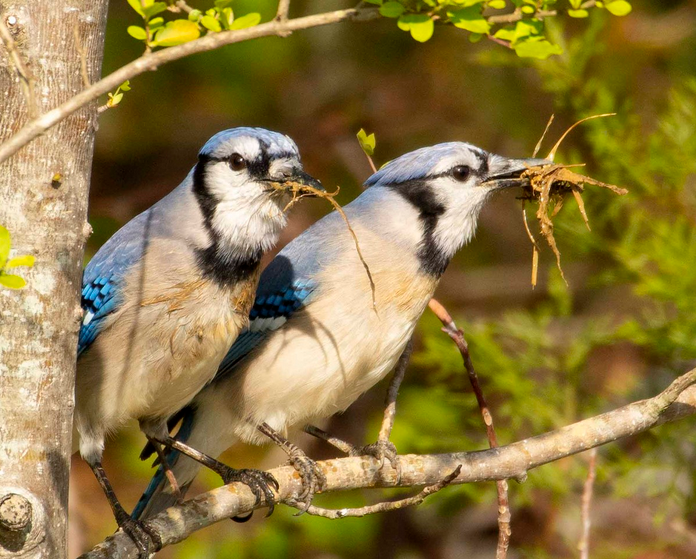
Pair of Blue Jays carrying nesting material by Keith Kennedy/Macaulay Library
Blue Jay
- Distribution: found in 97% of blocks in the second atlas
- Breeding Season: April through August
- Habitat: mixed forests and parks
- Nest Site: tree, shrub, or bush
- Nest: stick, twigs, roots, and grass, sometimes held together by mud, and lined with smaller vegetation
- Eggs: 4-5 variably colored and marked
- Incubation: 16-18 days, female only
- Fledging: leave nest at 17-21 days, fed by both adults
- Independence: cared by both parents another 3 weeks
- Broods: 1
- Common Atlas Codes: CN, NB, ON, FL, FY, FS, NY
- Atlas Tip: Blue Jays are normally quite vocal birds, so if you see one and it’s silent and/or acting sneaky, that’s a good indication it’s focused on its nest or young. Follow the quiet jays to increase your chances of observing breeding behaviors.

Barn Swallow nestlings by Laure Wilson Neish/Macaulay Library
Barn Swallow
- Distribution: found in 87% of blocks in the second atlas
- Breeding Season: late-May through July
- Habitat: open country near water
- Nest Site: in barns, on the side of buildings, and under bridges
- Nest: open cup nest made of mud and plant matter and lined with feathers
- Eggs: 4-5 white, smooth, and glossy eggs with some spotting
- Incubation: 14-16 days
- Fledging: leave nest at 17-24 days
- Broods: 2-3
- Interesting Fact: Barn Swallows can feed their young in mid-air
- Common Atlas Codes: CN, NB, UN, ON, FS, NE, NY
- Atlas Tip: Look for Barn Swallows around farms. If you suspect they are nesting in a farm building, you can try to confirm with the farmer. In the process, you might get information on other nesting birds and maybe even gain permission to bird on the property.
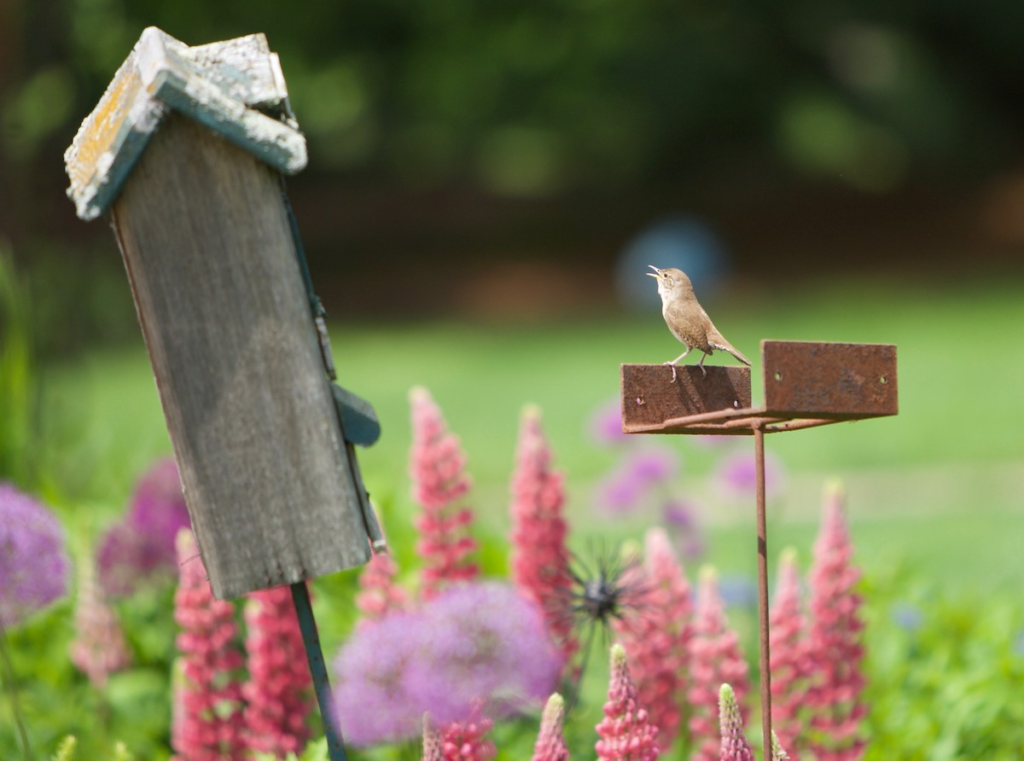
House Wren singing near a nest box by Robert Bruss/Macaulay Library
House Wren
- Distribution: found in 80% of blocks in the second atlas
- Breeding Season: mid-May through mid-August
- Habitat: varied—residential areas, open woodland, anywhere with shrubs, cavities, or other substrates to build a nest
- Nest Site: varied—nest boxes, natural cavities, on building ledges
- Nest: usually a cavity filled to the brim with plant matter and lined with feathers, hair, or wool
- Eggs: 6-8 white or pale pink with lots of small purplish speckles
- Incubation: 13-14 days, female only
- Fledging: leave nest at 12-18 days, fed by both parents
- Independence: fed by both parents another 13-19 days (female sometimes renests leaving the male to care for fledglings)
- Broods: 1-2
- Interesting Fact: House Wrens are aggressive and will sabotage the nests of neighboring birds (of the same or other species) by pecking holes in their eggs.
- Common Atlas Codes: B, FL, CF, FY, FS, NE, NY
- Atlas Tip: House Wrens are very vocal and nest in open areas so they are pretty easy to find, but be careful when coding nest building by this species. Wrens make multiple dummy nests so you can never be sure which nest is the real one until you see a higher code. Use the B code for wren nest building.
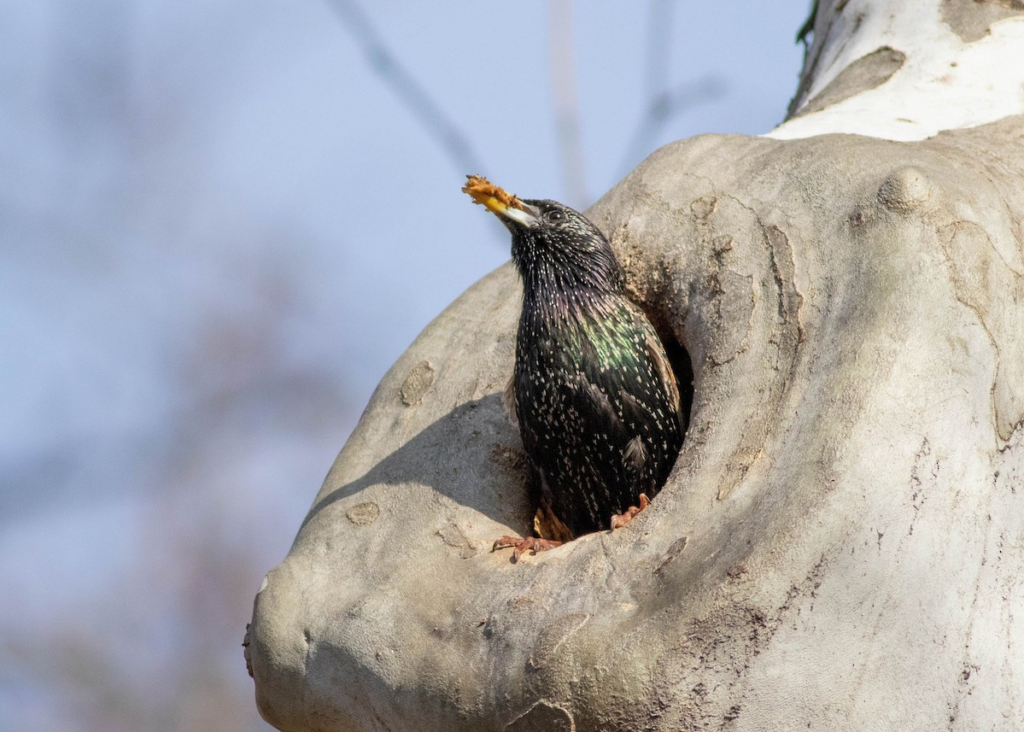
European Starling excavating a nest by Michelle Knoernschild/Macaulay Library
European Starling
- Distribution: found in 85% of blocks in the second atlas
- Breeding Season: April through August
- Habitat: varied—usually near open areas
- Nest Site: varied—trees, buildings, rocks, nest boxes
- Nest: cavity filled with plant matter and lined with feathers, wool or moss
- Eggs: 5-7 pale blue, smooth, slightly glossy
- Incubation: 12-15 days, both sexes
- Fledging: leave nest at 20-22 days, fed by both parents
- Independence: fed by both parents another 4-5 days
- Broods: 1-2
- Common Atlas Codes: CN, NB, ON, CF, FY, FS, NY
- Atlas Tip: Starlings are just as likely to nest in a forest as they are in a shopping mall. Always keep an eye out for them, even when you head to the supermarket or stop at a stop light (they like open pipes!), but don’t be surprised to find them in your favorite swamp either.
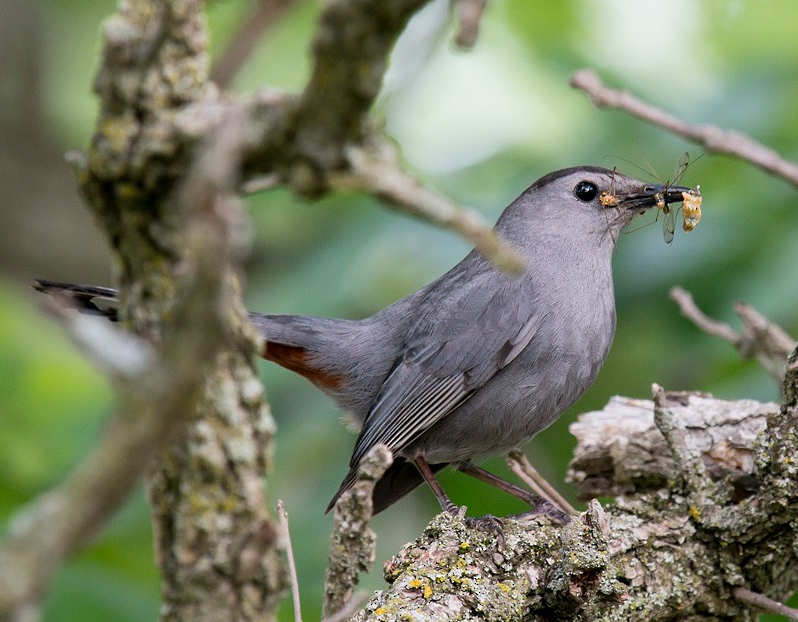
Gray Catbird carrying food by Mike Bailey/Macaulay Library
Gray Catbird
- Distribution: found in 89% of blocks in the second atlas
- Breeding Season: mid-May through mid-August
- Habitat: low, dense vegetation, sometimes near water but also orchards
- Nest Site: small tree, shrub, or bush, usually near the ground
- Nest: cup nest make of sticks, leaves, and grasses and lined with finer vegetation and sometime hair, string, and other materials
- Eggs: 4 unmarked, blue or greenish-blue eggs
- Incubation: 12-13 days, female only
- Fledging: leave nest at 11 days, fed by both parents
- Independence: fed by both parents another 24 days
- Broods: 2-3
- Common Atlas Codes: CN, NB, ON, FL, CF, FY, FS, NE, NY
- Atlas Tip: Once they return, catbirds are ubiquitous in shrubby areas. Since they nest in such dense vegetation, you are more likely to see them carrying nesting material or food than feeding young. But don’t worry if you miss their first brood. The have multiple broods and you can confirm breeding into August. It’s not unusual on a single outing to encounter one pair nest building and another pair busily collecting food.
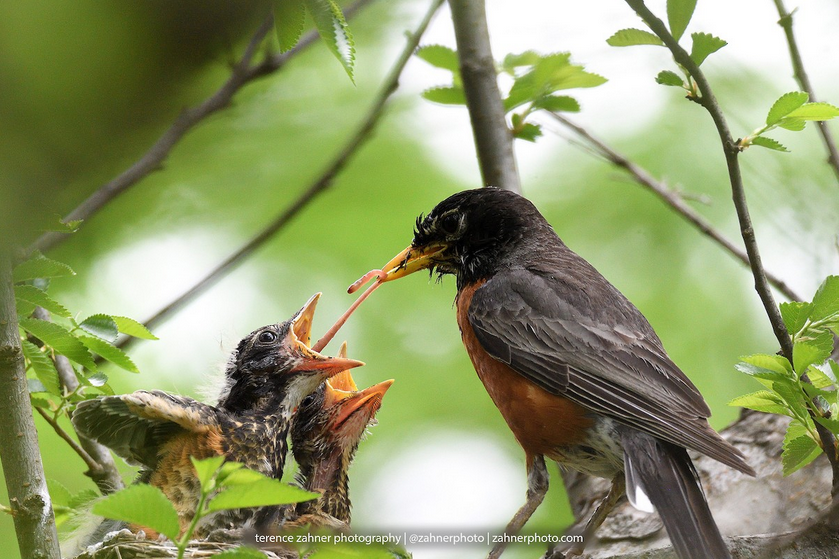
Male American Robin feeding nestlings by Terence Zahner/Macaulay Library
American Robin
- Distribution: found in 98% of blocks in the second atlas
- Breeding Season: May through July
- Habitat: varied—forest opening, farmlands, backyards
- Nest Site: varied—trees, shrubs, building ledges, cliffs, ground
- Nest: large cup nest, outer cup made of twigs, grasses, and other plant materials, inner cup of mud, and lined with grass
- Eggs: 5 pale blue (where the color “robin’s egg blue” comes from)
- Incubation: 11-14 days, female only
- Fledging: leave nest at 14-16 days, cared for by both parents
- Independencw: fed by male for 4 weeks
- Broods: 2-3
- Interesting Fact: once the young of one nest fledge, the female lays another clutch and incubates the eggs while the male raises the fledglings of the previous brood
- Common Atlas Codes: CN, NB, UN, ON, FL, CF, FY, FS, NE, NY
- Tip: It is possible to tell male robins from females. Males are brighter overall and have a darker, blackish head of the males as opposed to the gray heads of females. You usually don’t have to go out of your way to look for robin nests because they are often located near man-made structures and disturbed areas. Keep an eye out for birds frequenting the underside of eaves, the lower 20 ft of trees around your yard, and trail edges.



